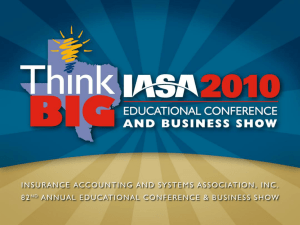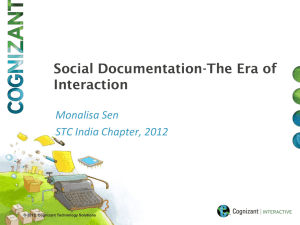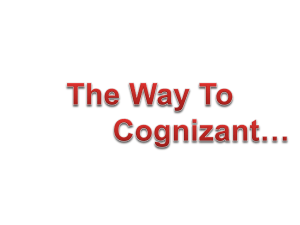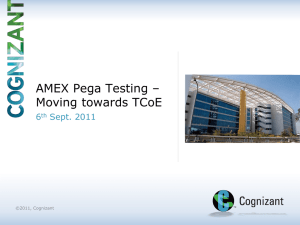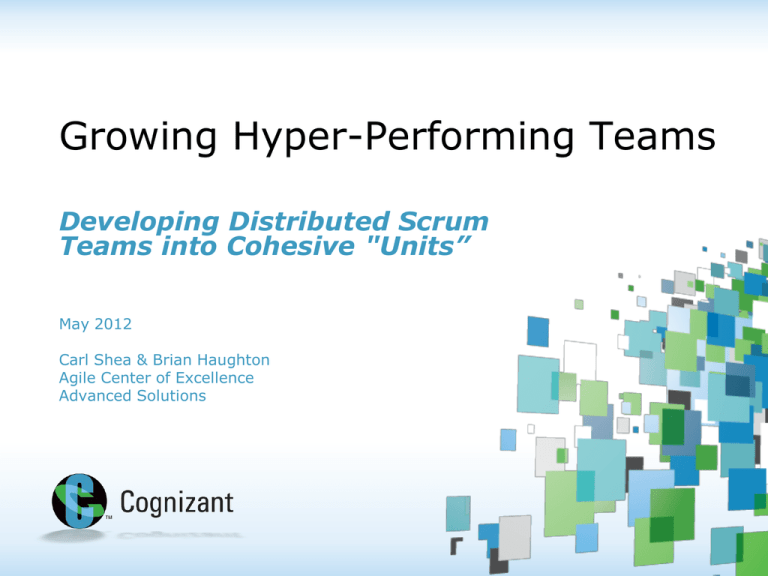
Growing Hyper-Performing Teams
Developing Distributed Scrum
Teams into Cohesive "Units”
May 2012
Carl Shea & Brian Haughton
Agile Center of Excellence
Advanced Solutions
About Cognizant Technology Solutions
• Founded in 1994 as a spin-off of Dun & Bradstreet
• Primary business focus is on new development, application maintenance and
consulting services
• 145,000+ employees
• Fortune 500 within 17 years of operations
• Market cap of $24 billion
• Active Customers: 700+
• 54 global delivery and development centers
• Member, Nasdaq-100 Index and Member, S&P 500 Index
• In Gartner ‘magic quadrant’ for outsourced services
| Copyright 2011, Cognizant Technology Solutions
2
Confidential
Cognizant Global Footprint
3
| ©2011 Cognizant Technology Solutions, Inc.
All rights reserved.
Cognizant’s Agile Center of Excellence
Cognizant has a growing Agile practice
in North America, Europe and India,
with new teams in Latin America
Over 50 Agile coaches and over 350
practicing Scrum Masters globally
Extensions of the CoE exist in all industry
segments
Cognizant has a extraordinary record of successful delivery of Agile projects
• We are at the forefront of how to deliver large, complex Agile projects at F500 clients using co-located, distributed
and integrated teams
Cognizant has experience with a range of client requests, from performing a pilot to transforming a
F500 enterprise
•
In 2004 Forrester Research described Cognizant as having a model for how to do distributed Agile successfully
Cognizant’s Agile CoE is part of the Advanced Solutions Group (ASG) and has specific solutions
in the following areas to help your client with their specific need:
•
•
•
•
Readiness Assessments
Consulting & Coaching
Delivery
Training
4
| ©2011 Cognizant Technology Solutions, Inc.
Advanced Solutions Group
Leaders in risk mitigation for complex
engagements
All rights reserved.
What is a Hyper-Performing Team?
The output of the team is greater than
the sum of the work of the individuals
on the team
5
| ©2011 Cognizant Technology Solutions, Inc.
All rights reserved.
Scrum Team Stages1
Level 1
Nascent
Follow the rule
New teams
Proficient
Level 2
Break the rule
Experienced
teams
High Performing
Level 3
BE the rule
Hyperproductive
teams
1
Much of the material in this first section builds on work by Lyssa Atkins in Coaching Agile Teams and
Alastair Cockburn @ http://alistair.cockburn.us/Shu+Ha+Ri
6
| ©2011 Cognizant Technology Solutions, Inc.
All rights reserved.
Characteristics of the Stages
Stage 3
Stage 2
Stage 1
7
①
②
③
④
① team customizes the practice of scrum staying true to
the values and principles
② team consistently thinks and acts as a cohesive unit
③ Emergent, adaptive properties and punctuated
equilibrium are seen in this team
team understands the practice of scrum
team begins to think and act as a unit
personality conflicts are put aside for the betterment of the team
team learns to “break the rules” but stay consistent with the
values and principles
① team struggles with the practice of scrum; principles & values seem too
theoretical
② a collection of skilled individuals, learning their roles, the process, & how to
work together
③ personality conflicts may arise and could distract the team from their work
| ©2011 Cognizant Technology Solutions, Inc.
All rights reserved.
Benefits of pursuing Stage 3
Hyper-productivity – the team will be able to produce quality software at an
amazing rate enabling a faster time to market and lower IT costs
Extremely efficient – the team will efficiently estimate, plan, execute and report
progress and impediments
Higher quality – fewer defects will result from their work
Predictable and consistent – their velocity is well known, consistent, and rangebound, allowing for greater confidence in future delivery estimates
Improved morale – members want to work together more for the betterment of the
team
Improved stakeholder satisfaction – business sponsors working with these teams
will enjoy working with the team
8
| ©2011 Cognizant Technology Solutions, Inc.
All rights reserved.
Do they EXIST?
9
| ©2011 Cognizant Technology Solutions, Inc.
All rights reserved.
Cognizant Case Study (2011)
Large Insurance and Financial Services Provider
Distributed
Agile
Company Overview: Leading global health
services and financial company. Provides an
integrated suite of healthcare services such as
medical, dental, pharmacy and vision care
benefits. Has operations in 27 countries and has
approximately 60 million customers world-wide
•
•
•
•
Situation
Client has multiple portals serving various
constituents – members, customers, health
care professionals and brokers
These portals were losing “industry leading”
status due to uncoordinated operating model
resulting in high call volumes and high support
costs
Client engaged Cognizant to deliver a “best in
class” online experience – A three year
program named Online Experience Program to
re-platform all the portals
Client's mandate was to deliver business
capabilities in shorter cycles with on-going
feedback from business, internal and external
stakeholders
10
Solution
Implemented Daikibo℠ Agile
Concept teams produce user stories
Delivery teams develop the stories
SIT-Agile team performing integration
testing – in sequential sprints
Integrated Rally into the process
Implemented customized reporting and
instrumentation to measure progress
Implemented an effective customized
release planning process
Agile Training for 100+ people by
experienced agile practitioners for quick
ramp-up of project teams.
| ©2011 Cognizant Technology Solutions, Inc.
All rights reserved.
Highlights
Large scale Agile development
Increased Scalability and
Velocity through “Daikibo
Scrum”
Trained and tooled Client IT
organization on Agile-Scrum
using Rally Software
Enabled Faster time to market
Benefits
Full-time business involvement resulted in
an enhanced user experience, which was
the primary objective of the program
The tools, the people, and the eco-system
for the project, including co-location and
collaboration between business and IT,
created an environment for the teams to
experience a rapid rise in velocity
Onsite and offshore teams achieved stage 2
(and one achieved stage 3!) to deliver 20%
more functionality than originally planned
for the release, following the original
timeline and budget
Cognizant Case Study (details)
Keys to Success
Custom Rally Reports
Full-time business involvement
Weekly review with executives
Collaborative spirit
Balanced consistency with flexibility
Teams were allowed to fail in a sprint
but felt empowered to own their success
Rally enabled transparency and helped
us to identify impediments sooner
Sprint Velocity
450
400
350
300
250
Story Points
200
# of Stories
Sprint
Story Points
# of Stories
Sprint 2
33
14
Sprint 3
65
21
Sprint 4
137
52
Sprint 6
239
63
Sprint 8
348
112
Sprint 10
404
124
150
100
50
0
Sprint 2
Sprint 3
1
Sprint 4
Sprint 6
Sprint 7
Sprint 9
Sprint 10
| ©2011 Cognizant Technology Solutions, Inc.
All rights reserved.
Developing hyperperforming scrum teams
12
The Agile Benefits Curve™
Benefits
Benefits
Higher productivity
Lower costs
Faster time to market
Higher quality
Improved team morale
Improved stakeholder satisfaction
Achieved by
hyper-performing teams
Maturity in Agile has a direct
correlation to the benefits
received.
Inflection point #4:
hyper-productive
teams reach their
potential
Inflection
point #1:
benefits
become
positive
Stage 3
(4x-12x)
Inflection point #3:
some teams become
hyper-productive
Substantial benefits
Stage 2 (2x-3x)
Typical waterfall productivity level
Minimal benefits
Stage 1
Time
Startup
investment
13
Peak benefits
+ bonus benefit: predictability
Inflection point #2: teams are experienced and
begin to achieve greater velocity
| ©2011 Cognizant Technology Solutions, Inc.
All rights reserved.
The Model for Hyper-Productivity
Agile Executive Support
14
Agile-friendly Eco-System
| ©2011 Cognizant Technology Solutions, Inc.
All rights reserved.
Agile Team
Agile Executive Support
Provide environment for innovation to thrive
Agile Executive Support
Include basic structure and guidance for
metrics, reporting, and oversight
Provide latitude and flexibility to Agile teams
to support business stakeholders in best
way possible
Provide coordination for across-the-board
issues
Implement oversight at the senior
leadership level
Provide quick-to-the-top escalation path
Operational drive at the portfolio level
Drive the creation of the Agile-friendly ecosystem
Identify and discourage anti-Agile behavior
15
| ©2011 Cognizant Technology Solutions, Inc.
All rights reserved.
Establishing the Agile-friendly Eco-system
Agile teams:
Human
Resources
Composed of 7-10 people
Product owner
Scrum master
Business analysts
Developers
Testers
Treated like a military unit
Deployed to successive projects
Members have a sense of duty
Peer pressure enables cohesion
Finance
Business
Leadership
ePMO
Technical
architects
UI
design
Legal
Project
steward
SME
Agile
team
Business
Units
Statistician
IT Leadership
Operation
s
16
| ©2011 Cognizant Technology Solutions, Inc.
Agile Governance is
required to implement
the eco-system
Operations
Leadership
Marketing
The closer the role/group is to the agile team,
the more they need to modify their own
internal processes to support and enable the
agile team to achieve their potential. Some
level of training/awareness is required for all.
All rights reserved.
The Agile Team
Goals of Adopting Agile
Hyper-performing (stage 3) team
Becoming one cohesive unit
The goals of adopting Agile methods are best realized by the
creation of hyper-performing teams.
Hyper-performing levels can only be achieved when the team
becomes “one cohesive unit”.
17
| ©2011 Cognizant Technology Solutions, Inc.
All rights reserved.
Maturity Through Failure?
Must a team fail before they can achieve
a hyper-productive state?
1
| ©2011 Cognizant Technology Solutions, Inc.
All rights reserved.
Key Success Factors to Achieve Stage 3
Caveat: Many teams never achieve Stage 3, and there is no average timeline for
a team to achieve the highest stage despite extensive research on this point.
Many factors must come together before it is possible.
The scrum team must have no departures or additions for a period of time.
The person in the Product Owner role cannot change on a project.
The team is small; 10 people or less.
The team is empowered to change its process.
The team incorporates the core values in their work.
It’s difficult for a team to reach stage 3 that has not failed at least once.
The team must bond via a difficult challenge (similar to the boot camp experience).
Team members are committed to shared success (i.e. success/failure as a team).
The team is able to stay intact and move from one project to another.
Team members must be hungry to learn, willing to accept change, and eager to experiment with new
ideas.
Business and Technology leadership provide necessary support and are helpful in removing
impediments.
19
| ©2011 Cognizant Technology Solutions, Inc.
All rights reserved.
Chemistry and The Metaphor
Team chemistry is extremely important.
Team Chemistry = rapport between individual team members. It’s the glue that
enables the team to deliver.
Company culture = team chemistry multiplied across many teams and orgs
Peer Pressure
is always
greater
than
A combat
team may be composed
of specialists
(like an
explosives expert or expert marksman) and/or generalists
(like Management
a rifleman), but everyone is on
the team for a specific
Pressure
purpose.
For a team to progress toward stage 3 – the Scrum team should be
like a SEAL combat team.
•
• Each team member must support the others for the mission
to succeed.
• The drive to succeed for a common goal increases group
cohesion.
• Peer pressure pushes individuals to perform their best.
20
| ©2011 Cognizant Technology Solutions, Inc.
All rights reserved.
Distributed Scrums?
Must Agile teams work in the same room, face-to-face every day for the project to succeed?
NO
The key is the rapport between the team members, regardless of geographical separation. Emotional
distance is the problem – not physical distance.
With good rapport, location transparency can be achieved.
Can a fully distributed scrum team be just as productive as a scrum team in the same
room?
Can large enterprise implementations with fully distributed Scrum teams be just as
productive as one with all teams in the same location?
Who says so?
Tom Grant of Forrester Research published his independent findings at the Agile
Alliance 2010 conference.
• Jeff Sutherland published his findings in The Scrum Papers, 2010, pp. 88-104, calling
it the “integrated scrum team” model.
•
21
| ©2011 Cognizant Technology Solutions, Inc.
All rights reserved.
Best Practices for Distributed Agile Teams
KEYS TO SUCCESS:
build rapport, support each other, talk daily, and be social
When a distributed team is first formed…
•
•
•
•
Attend jumpstart training together in-person
Use the introduction brochure technique
Name the team and decide on a mascot
Discuss the values
Host the entire team onsite (or offsite!) to build rapport
•
•
When they start a new project
At least once per year (the 360+5 plan)
Use video conferencing whenever possible
Plan for and perform a cultural exchange with each location
•
•
Celebrate exchanged holidays – Indians celebrate Thanksgiving; Americans celebrate Diwali
Learn words in the native language of other team members
Take pictures of team members and post them on the wall at each location
Use the man-in-the-air technique to build rapport
Create the team celebration plan
Spend time together away from the office – playing, performing or watching events with a common
interest
Provide incentives through friendly competition with other teams
Use a best-in-class ALM toolset
Allow the team to fail (in a sprint) when they overcommit
2
| ©2011 Cognizant Technology Solutions, Inc.
All rights reserved.
Thank you
Brian.Haughton@cognizant.com
Carl.Shea@cognizant.com
23
Sutherland Case Study of SirsiDynix* (2005)
Documented as distributed integrated Scrums that achieved a hyper-productive state
Results
•
•
Proved that a large enterprise project (56+ developers) run with distributed integrated Scrums can
be as productive as a small co-located Scrum team
Proved to be 8X more productive than a parallel project performed with Waterfall, resulting in
“…more functionality and higher quality.”
Characteristics
•
•
•
2 week sprints, with a few use cases but most as user stories
Teams in Provo Utah and St Petersburg Russia, with a few key individuals working from Seattle,
Denver, St Louis and Waterloo Canada
Used Jira/Greenhopper for their ALM
Best Practices
•
•
•
•
•
•
Daily scrum team meetings from multiple sites
Daily meetings of Product Owners
Automated builds from one central repository
No distinction between team members at different sites
Followed sound engineering practices constantly
Seamless integration of some XP practices, refactoring, continuous integration, limited pair
programming on most complex technical components
* Sutherland Scrum Papers, Distributed Scrum: Agile Project Management with Outsourced Development Teams, 2010, pp. 88-104
24
| ©2011 Cognizant Technology Solutions, Inc.
All rights reserved.
Daily Report – Customized Rally
25
| ©2011 Cognizant Technology Solutions, Inc.
All rights reserved.
Becoming One Cohesive Team
Principles & Practices:
Properties of a Hyper-performing Team
The team succeeds or fails together
Everyone is on the team for a specific
purpose
Everyone is expected to “pull their weight”
Everyone is expected to have a shared
sense of duty and purpose
Achieved by
Exercise the strengths of the individuals of
the team, and work to minimize the
weaknesses
If one team member becomes “stuck,” other
team members have a responsibility to help
them – to the best of their ability and skill
If the team fails to meet their commitment,
they are expected to learn from their failure
and adapt
There is no change in team composition or
structure for an extended duration
The team should expect to be “deployed” to
successive projects, one after another
26
| ©2011 Cognizant Technology Solutions, Inc.
All rights reserved.
Dealing with Failure
Executives and management must understand the model, and the consequences of their actions.
•
•
Failure of one sprint is ok – maybe even a good thing for the team.
A failure trend is not good. A Coach should be brought in to assess the situation.
# Action
Consequences
1
Extend the sprint
2
Add people to the
team
3
Reduce the scope
of the sprint
4
Avoid calling it a
failure – “failure is
such a negative
term”
+/−
Sprint boundary becomes unpredictable.
Team perceives that they will always be
bailed out when they overcommit.
Estimation becomes less important. Metrics
become meaningless. Predictability
decreases. Team growth toward stage 3 is
limited.
−
People aspire to join the “swat team” – the
elite group that “saves” other teams.
−
The commitment the team makes becomes
meaningless.
−
Team never passes through the bonding
experience of failure. Estimation and
commitment become less important since
there’s little to no pain for failure.
Team may be able to achieve stage 2,
however probability of achieving stage 3 is
reduced significantly.
−
5
Blame others
(i.e. external
dependencies)
Team perceives that they are never in the
wrong. Verticals slices feel too difficult; feel
the need to re-define velocity since they
cannot complete committed work in a
sprint.
Team may be able to achieve stage 2, but
never stage 3.
−
6
Admit failure and
discuss improvement
options in their
retrospective
Team members perceive that they are “on
their own” – working “without a safety net”
– and that they must get along with each
other and discover each other’s
strengths/weaknesses if they are to
succeed.
The team will grow into acting and
thinking more like a cohesive unit,
progressing towards stage 3.
+
27
| ©2011 Cognizant Technology Solutions, Inc.
All rights reserved.







